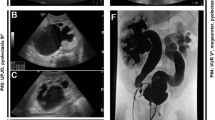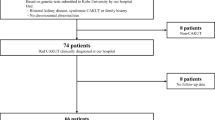Abstract
Medullary sponge kidney (MSK) is a congenital renal disorder. Its association with several developmental abnormalities in other organs hints at the likelihood of some shared step(s) in the embryogenesis of the kidney and other organs. It has been suggested that the REarranged during Transfection (RET) proto-oncogene and the Glial cell line-Derived Neurotrophic Factor (GDNF) gene are defective in patients with MSK, and both RET and GDNF are known to have a role in the development of the central nervous system, heart, and craniofacial skeleton. Among a cohort of 143 MSK patients being followed up for nephrolithiasis and chronic kidney disease at our institution, we found six with one or more associated non-renal anomalies: one patient probably has congenital hemihyperplasia and hypertrophic cardiomyopathy with adipose metaplasia and mitral valve prolapse; one has Marfan syndrome; and the other four have novel associations between MSK and nerve and skeleton abnormalities described here for the first time. The discovery of disorders involving the central nervous system, cardiovascular system and craniofacial skeleton in MSK patients supports the hypothesis of a genetic alteration on the RET–GDNF axis having a pivotal role in the pathogenesis of MSK, in a subset of patients at least. MSK seems more and more to be a systemic disease, and the identification of extrarenal developmental defects could be important in arousing the suspicion of MSK in recurrent stone formers.
Similar content being viewed by others
References
Gambaro G, Feltrin GP, Lupo A, Bonfante L, D’Angelo A, Antonello A (2006) Medullary sponge kidney (Lenarduzzi-Cacchi-Ricci disease): a Padua Medical School discovery in the 1930s. Kidney Int 69(4):663–670
Fabris A, Lupo A, Bernich P, Abaterusso C, Marchionna N, Nouvenne A, Gambaro G (2010) Long-term treatment with potassium citrate and renal stones in medullary sponge kidney. Clin J Am Soc Nephrol. 5(9):1663–1668
Gambaro G, Danza FM, Fabris A (2013) Medullary sponge kidney. Curr Opin Nephrol Hypertens 22(4):421–426
Gambaro G, Fabris A, Citron L, Tosetto E, Anglani F, Bellan F, Conte M, Bonfante L, Lupo A, D’Angelo A (2005) An unusual association of controlateral congenital small kidney, reduced renal function and hyperparathyroidism in sponge kidney patient: on the track of the molecular basis. Nephrol Dial Transplant 20:1042–1047
Fabris A, Anglani F, Lupo A, Gambaro G (2013) Medullary sponge kidney: state of the art. Nephrol Dial Transpl 28(5):1111–1119
Torregrossa R, Anglani F, Fabris A, Gozzini A, Tanini A, Del Prete D, Cristofaro R, Artifoni L, Abaterusso C, Marchionna N, Lupo A, D’Angelo A, Gambaro G (2010) Identification of GDNF gene sequence variations in patients with medullary sponge kidney disease. Clin J Am Soc Nephrol 5(7):1205–1210
Homma S, Oppenheim RW, Yaginuma H, Kimura S (2000) Expression pattern of GDNF, c-ret, and GFRalphas suggests novel roles for GDNF ligands during early organogenesis in the chick embryo. Dev Biol 217(1):121–137
Hiltunen JO, Laurikainen A, Airaksinen MS, Saarma M (2000) GDNF family receptors in the embryonic and postnatal rat heart and reduced cholinergic innervation in mice hearts lacking ret or GFRalpha2. Dev Dyn 219(1):28–39
Fabris A, Bernich P, Abaterusso C, Marchionna N, Canciani C, Nouvenne A, Zamboni M, Lupo A, Gambaro G (2009) Bone disease in medullary sponge kidney and effect of potassium citrate treatment. Clin J Am Soc Nephrol. 4(12):1974–1979
Viljoen D, Pearn J, Beighton P (1984) Manifestations and natural history of idiopathic hemihypertrophy: a review of eleven cases. Clin Genet 26:81–86
Tomooka Y, Onitsuka H, Goya T, Hayashida Y, Kuroiwa T, Kudo S et al (1988) Congenital hemihypertrophy with adrenal adenoma and medullary sponge kidney. Br J Radiol 61:851–853
Priyamvada PS, Parameswaran S, Sandeep M, Shankar V, Swaminathan RP (2014) Medullary sponge kidney and isolated hemihyperplasia. Indian J Nephrol 24(4):243–245
Clericuzio CL, Martin RA (2009) Diagnostic criteria and tumor screening for individuals with isolated hemihyperplasia. Genet Med 11(3):220–222
Chow K, Pyeritz RE, Litt HI (2007) Abdominal visceral findings in patients with Marfan syndrome. Genet Med 9(4):208–212
Schoeneman MJ, Plewinska M, Mucha M, Mieza M (1984) Marfan syndrome and medullary sponge kidney: case report and speculation on pathogenesis. Int J Pediatr Nephrol 5(2):103–104
Tuo G, Pini Prato A, Derchi M, Mosconi M, Mattioli G, Marasini M (2014) Hirschsprung’s disease and associated congenital heart defects: a prospective observational study from a single institution. Front Pediatr 2:99. doi:10.3389/fped.2014.00099
Sarioglu A, Tanyel FC, Büyükpamukçu N, Hiçsönmez A (1997) Hirschsprung-associated congenital anomalies. Eur J Pediatr Surg 7(6):331–337
Fabris A, Lupo A, Ferraro PM, Anglani F, Pei Y, Danza FM, Gambaro G (2013) Familial clustering of medullary sponge kidney is autosomal dominant with reduced penetrance and variable expressivity. Kidney Int 83(2):272–277
Author information
Authors and Affiliations
Corresponding author
Ethics declarations
Conflict of interest
None of the authors have any potential conflict of interest to disclose.
Ethical approval
No animals were involved in the study. All procedures performed in studies involving human participants were in accordance with the ethical standards of the institutional and/or national research committee and with the 1964 Helsinki Declaration and its later amendments or comparable ethical standards.
Informed consent
Informed consent was obtained from all individual participants included in the study.
Rights and permissions
About this article
Cite this article
Ria, P., Fabris, A., Dalla Gassa, A. et al. New non-renal congenital disorders associated with medullary sponge kidney (MSK) support the pathogenic role of GDNF and point to the diagnosis of MSK in recurrent stone formers. Urolithiasis 45, 359–362 (2017). https://doi.org/10.1007/s00240-016-0913-6
Received:
Accepted:
Published:
Issue Date:
DOI: https://doi.org/10.1007/s00240-016-0913-6




